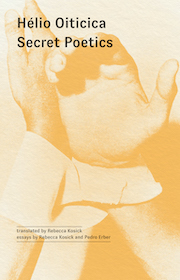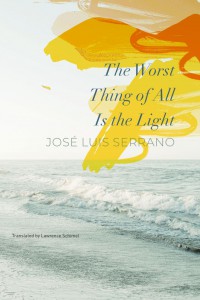In this month’s round-up of new and noteworthy titles from around the world, our editors dive in to a lyrical, transcendent, and multidisciplinary collection from the founder of neoconcretismo, Hélio Oiticica, and a sensuous, genre-bending queer love story of from José Luis Serrano. Read on to find out more!

Secret Poetics by Hélio Oiticica, translated from the Portuguese by Rebecca Kosick, Winter Editions/Soberscove Press, 2023
Review by Sofija Popovska, Editor-at-Large for North Macedonia
How can we eternalize the moment without petrifying it? How can words convey its temporal unfolding while retaining the anatomy of that process, a duration that has no discernible borders? A possible answer can be found in Hélio Oiticica’s Secret Poetics, translated from the Portuguese by Rebecca Kosick. In this collection, the reader is invited to experience a gallery of the ephemeral: the motion of a plunge into water; the cold, vexing, soon-to-be-over wait for the arrival of a lover; the tidal separations and interlacings of limbs and lips in an amorous embrace… Like a gifted translator, Oiticica recasts the transient into another medium—words and silences—while remaining true to that fleeting essence: to, in his own words, “immediacy that becomes eternal in lyrical poetic expression”.
In the preface, where she thoroughly examines the correspondences between Oiticica’s poetry and his visual work, Kosick reveals that his output has been termed “unclassifiable”. Its hybridity goes deeper than the blurring of genre distinctions (Oiticica’s practice “included painting, sculpture, installation, performance, filmmaking, and writing”), and this artistic output itself constitutes moments of coalescence and transformation. While his earlier pieces, a series of paintings, contained “a suggestion of movement, even dance,” Kosick notes that his “later artworks would literalize this proposition”. In 1959, Oiticica and a group of his contemporaries launched the “neoconcrete” movement, creating three-dimensional art installations designed to be interacted with by the audience. Composed of objects that could be rotated, worn, opened, and reached into, these installations “not only dissolved the distance between spectator and art object but collapsed the very binaries structuring the differentiation of subject and object”. Kosick explains that the experiences of the pieces redefined “the work of art as ‘a being’ whose meaning would ‘flourish’ via phenomenological encounter with its audience-participants”.
Both temporally coincidental with and thematically inseparable from his body of visual work, Oiticica’s poetry is equally participatory. As Pedro Erber notes in the closing essay, “Oiticica’s Phenomenological Lyric; or, the De-Intellectualization of Art”, the “mutual imbrication” of poetry and art serves to rescue the ephemeral from ossification in images, “to restore the immediacy of everyday experience—which the plastic embraced but ultimately concealed and, thus, effectively excluded”. On the boundary between the plastic and poetic, Erber argues, is dance—an art form of both creative and biographical importance to Oiticica. On the artistic plane, dance “represented for him the quintessential site of de-intellectualization”—a step back from assigning conceptual counterparts to every inch of the human experience; and in regards to his life, his participation in the samba scene in Mangueira “constituted an act of transgression of social barriers and class conventions”. Oiticica’s poetry embraces dance as an “ideal model”, its reliance on “lived experience” and “its openness to the world”. Simultaneously, inspired by Merleau-Ponty (who was, incidentally, “the best ballroom dancer in the Parisian postwar intellectual scene”), it acknowledges that there are parts of experience inaccessible to linguistic expression, and strives to include them via a “phenomenological lyric”. This new lyric does not state “subjective emotions or feelings”, but rather invites the reader to experience their own, by relating moments of sensing, touching, smelling, encountering. Both dance and the phenomenological lyric imply a dual engagement, and like a partner, the poetry reader’s inner world is set into motion by cues derived from the poem, transforming into a site where the unspeakable unfolds. The reader, like the neoconcrete artwork, is exalted through participation; instead of being mere voyeurs, they become the necessary factor in completing the expression of the fleeting and linguistically inaccessible. And perhaps learning from movement—which is nothing without stillness—the way Oiticica achieves this symbiotic poet-reader relationship is through his deployment of not only words, but also silences.
A perfect example of this is the miniature poem written on August 23, 1964:
Water,
glassy surface,
Plunge.
“Plunge” is rendered all the more powerful by being encased in silence. Firstly, it mimes the acoustic image of a diver entering a body of water—the single, abrupt sound it engenders. Secondly, it leaves space for the reader’s imagination to form its own sensory picture of the plunge: whether the water is permeated by sunlight or cold and dark, whether the body slips into a fizzy cloud of bubbles or into a quiet, monochromatic serenity—it’s up to the mind that interacts with the words. By leaving its imagery incomplete through its elliptical style, this poem succeeds in eternalizing the fleeting without causing it to congeal into a concept: it will continue to transform with every new reader that encounters it.
Kosick’s description of her hesitation between “plunge” and “dive” to convey the Portuguese “mergulho” showcases the participatory element at work. The silence surrounding “plunge” was, in her experience, a receptacle for a childhood memory: “If I had been translating this poem without consulting the artwork,” she writes, “I might have gone with ‘dive’ instead of ‘plunge.’ I grew up around lakes, and that’s the image that comes to me first when I read the poem.” In the end, the hybrid nature of Oiticica’s oeuvre determines the translation: “This three-liner relates directly to B47 Bólide caixa (Fireball Box) 22 “Mergulho do corpo”, a water tank Oiticica made in 1966/67 whose surface looks, indeed, glassy. . . the conventional English translation for the work’s subtitle is “Plunge of the Body.”
This explication shows both Kosick’s attention to the continuity between Oiticica’s plastic and poetic work, and how knowledge of his corpus has informed her deliberate approach to rendering his voice into English. In other instances, she maintains the “sonic wordplay” by “emphasizing lexical similarities” regardless of etymology, a practice in line with neoconcrete approaches, such as her choice to translate “the sonic resonance of the Portuguese o sono (the sleep) and o sonho (the dream) less literally as ‘the drift-off’ and ‘the dream’, in order to generate interlingual resemblances where English affords them.” By bringing non-Portuguese speaking readers as close as possible to experiencing the original, Kosick reveals to the anglophone public a poetic cycle that is truly one-of-a-kind. All that remains is for readers to experience Oiticica’s poetry for themselves, and make its silences their own—after all, when reading Secret Poetics, one is simultaneously doing so as a fellow writer, and a partner in this dance.

The Worst Thing of All Is the Light by José Luis Serrano, translated from the Spanish Lawrence Schimel, Seagull Books, 2023
Review by Samantha Siefert, Marketing Manager
The worst thing of all is the light of memory, which shines upon the quiet questions of the heart: the things that were, that are, that could be. . . The light in this case is the pervasive metaphor of José Luis Serrano’s supremely artistic novel, The Worst Thing of All Is the Light, translated from the Spanish by Lawrence Schimel, and the central question of this novel is that eternal one: in the cloudy gray spaces between love and friendship, where does the boundary lie?
With no intention to search for precise answers, Luis Serrano sets to a pondering prose that is as much collage as it is novel, blending poetry, music, photography, and diary to transport readers into a Basque Country story that explores the lives of two couples in parallel. The first is made up of Serrano himself and his husband, an openly homosexual couple in their fifties, enjoying the idle days of a summer vacation in 2014 Bilbao as the author contemplates his current work; the second is Edorta and Koldo, the subjects of Serrano’s novel, a pair of heterosexual Basque men who find friendship too weak a label and love perhaps a little too brave. Their stories are juxtaposed through a series of first-person entries that alternate between the perspectives of the author and Edorta, who each contemplate the nature of their relationships.
If the structure sounds odd, the author’s husband agrees: “But this novel is convoluted, no? Especially because of the subject. I don’t even know what you’re going to say when they ask you what it’s about.” Dialogues with his husband comprise most of the author’s segments, with the former often serving as a sounding board for the story. Their chatting is comfortable and leisurely, with each chapter opening to a new day where they assess the weather, plan a trip to a nearby town or beach, pack a bag, and sink into each other’s company. They discuss whatever they feel like, but mostly their stand-ins, Edorta and Koldo, and what merits inclusion in their story of heterosexual love between men. “And don’t you think that with these dialogues, with the novel’s duplicate structure, with the whole issue of Sarah Records, with Blas de Otero, with the photos, with the diaries whether or not they’re written a posteriori, that you’re doing precisely the opposite, getting sidetracked from the subject?” his husband asks. But the author is determined, and every artifact serves its purpose.
Like a well-paced mystery novel, details that present subtle question early in the story of Koldo and Edorta are addressed in the fold. Edorta’s segments track their friendship from its onset in the eighties, when they meet at school, to the contemporary summer, through a series of vignettes that piece together the complexities of their relationship. Their friendship follows a common course: school, sports, coming-of-age—but despite the familiar construction of a deep bond forged with time, it suffers an unrelenting anguish to conform to existing labels. Edorta is a writer like the author, but without the author’s capacity to speak openly with his partner, Edorta struggles internally, sharing his torment to define their relationship mostly with the pages of his diary:
That was the tragedy of our love. Love because I didn’t know another word, because I hadn’t been shown one, because there were others I could have used—affection, friendship, companionship, trust, camaraderie . . . but none of them fit, none explained everything. That was the worst thing of all: I gave it a name and it was love. And for you . . . I don’t know if you liked it.
For Edorta the worst thing of all is the light, as he begins again and again in his diaries, because it is constant, unchanging yet shining on them in new ways as they change with time, as their time together too becomes fleeting, pushed aside for work, marriage, and children. The worst thing of all is the light, he repeats, as he traces the intersections of their lives in a desperate effort to give their connection some permanence.
“But let me get back to the basics” the husband asks, “do they want to fuck one another or not? Do they desire one another sexually or not?” For him—and for the readers, he says—that is the dividing line. “Of course not, that’s the first thing I told you, it’s the premise of the novel!” the author insists. Despite this certainty, the question persists in every possible light, leaving the reader in ambiguity. As the author’s husband suggests, the novel is convoluted, but if you turn something opaque to look at it from every possible angle, it may eventually show its cracks.
As the story stretches back and forth across time, a deep sense of place becomes the anchor that moors the two stories to common ground. Elegant descriptions of Bilbao and the surrounding Basque countryside are accompanied by black and white photographs of austere landscapes interspersed within the text, and Lawrence Schimel’s excellent translation adds depth by including Spanish and Basque phrasing to great effect. Because the setting is constant yet necessarily evolving with time, the overlap of the stories becomes more poignant. The easy days of the author and his husband’s vacation overlay the same spaces occupied by Edorta and Kaldo’s complicated love, highlighting their differences, and when the author’s vacation comes to a close at the end of the summer and the timelines converge, the sameness of a love with different names comes into focus.
The Worst Thing of All Is the Light is a sleeper hit, a quiet novel that packs a punch. It is a story that weaves circles around itself, because the search for answers is just as important as the answers themselves, and as such it is the kind of book to finish and begin again, because there is always room to consider something more carefully. In a world where so much is ephemeral, this is a novel you can hold on to, to keep in your back pocket like an old friend or a lover, to turn to when you feel the need, yet again, to contemplate the lines between love and friendship, what was, what is, and what could be.
*****
Read more on the Asymptote blog:

